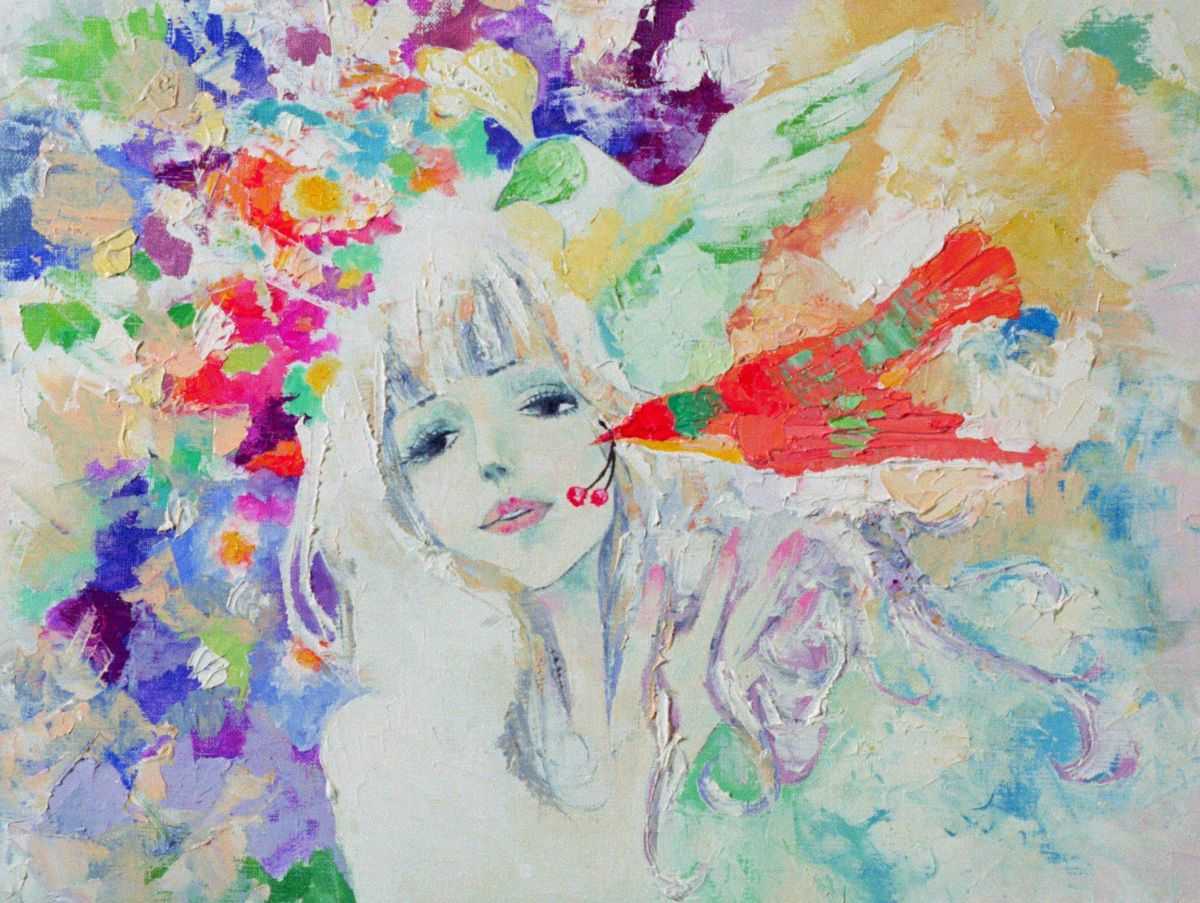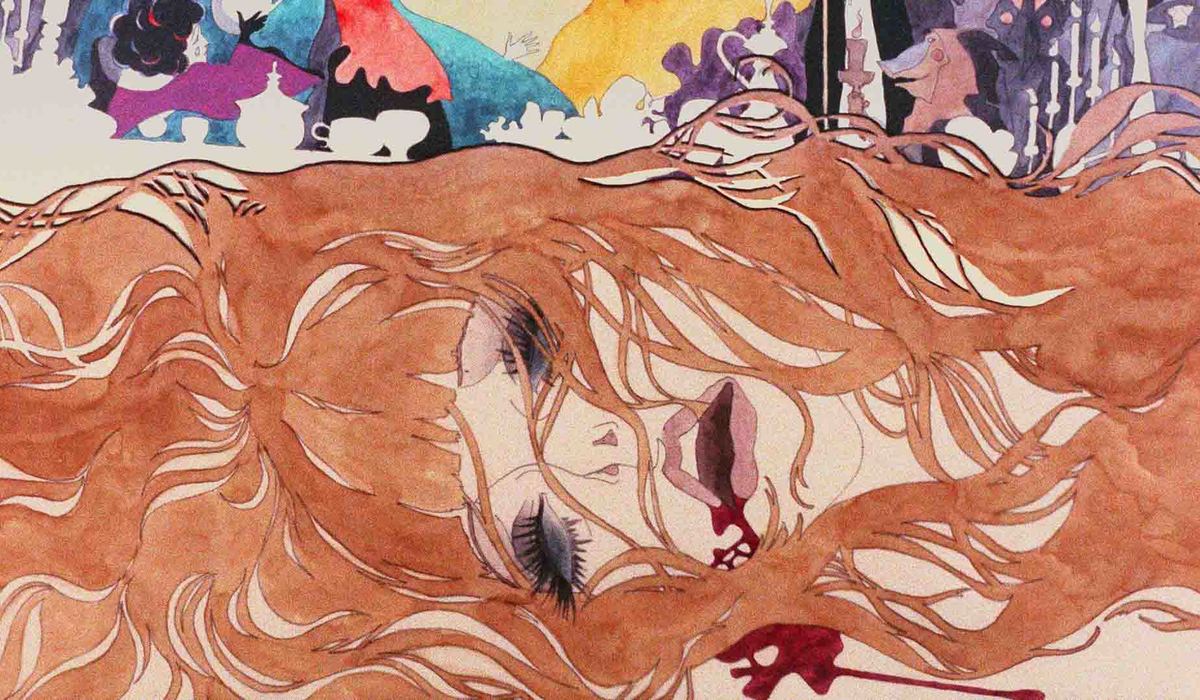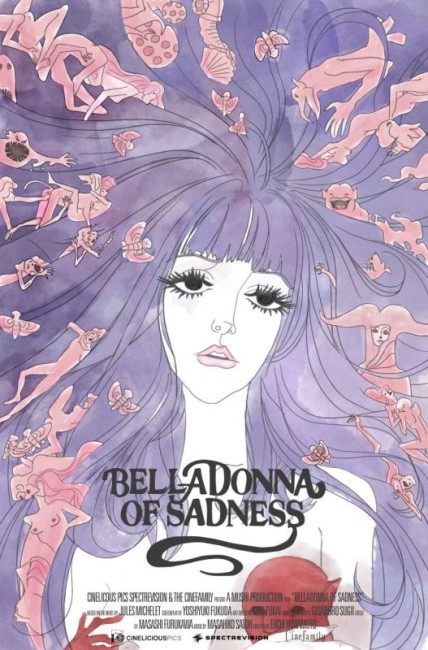(Kanashimi no Beradonna)
Crew
Director – Eiichi Yamamoto, Screenplay – Yoshiyuki Fukuda & Eiichi Yamamoto, Based on the Novel La Sorciere by Jules Michelet, Music – Masahiko Satoh, Animation Director – Gisaburo Sugii, Art Direction – Kuni Fukai. Production Company – Mushi Productions.
Plot
Jean and Jeanne are married. The Baron who owns the land in the area demands ten cows as tax from them for his permission to marry. Because they cannot pay, the baron takes Jeanne in lieu and ravages her. After Jeanne stumbles home, a tiny devil appears and erotically tempts her but she refuses its offer to sell her soul for power. Under the devil’s guidance, Jeanne uses her wiles to seduce and have Jean appointed tax collector. She becomes so powerful that she threatens the Baron’s rule. After the Black Plague strikes the area, the devil transforms Jeanne into a witch with the ability to heal the locals.
Osamu Tezuka (1928-89) is best known for his comic-books and anime films – as director, writer and producer of various Japanese films such as Alakazam the Great (1961) and Space Firebird 2772 (1979) and tv series like Astro Boy (1963) and Kimba the White Lion (1965-7). What is less well known about Tezuka is that he also made erotic films. He had formed Mushi Productions in the early 1960s and there made a trilogy of erotic anime films with 1001 Arabian Nights (1969), Cleopatra (1969) and Belladonna of Sadness. He co-directed the first two films with Eiichi Yamamoto, a Tezuka associate who had worked as a director on the Astro Boy and Kimba tv series. Yamamoto was given sole directorship of Belladonna of Sadness.
Belladonna of Sadness was made when Mushi was financially floundering – indeed, Belladonna of Sadness would be the last film Mushi would ever produce and the studio went into receivership the same year. As a result, the film is made with very limited animation – often just static watercolour artwork, even pencil sketches at times, or where only limited parts of the frame move. It often becomes an uphill push to watch Belladonna of Sadness through the stationary shots and lack of motion in many scenes. It is almost a film that seems designed to defy expectations anybody has of an animated film – it is hard to think of anything further removed from the artistic sensibilities (not to mention content) of Disney, Pixar, Blue Sky et al. Despite this, Belladonna of Sadness premiered at Cannes and has gone on to become regarded as a cult film in its recent revival.

Eiichi Yamamoto’s animation finds a unique stride between eroticism and abstraction/surrealism. The art is suggestively erotic combined with the florid paisley psychedelic of 1970s pop design. The initial scene where Jeanne is violated by the Baron is represented by her womb and half her body being split almost in two by a giant red wedge and the Baron’s wife sitting nearby transformed into a crow.
The most dazzling sequence is the orgy among the villagers where they undergo a mind-boggling array of erotic transformations – men whose dicks are horses or giraffes, have trees growing out of their crotches, women whose wombs becomes tigers, a character with birds emerging out of his anus, duelling intertwined cocks, a dick tongue, fish emerging out of a woman’s vagina and so on.
For all its being held up as a groundbreaking work of sexuality that was before its time, Belladonna of Sadness also comes with some attitudes that are shall we say on the conservative side. It holds the association that for a woman to become erotically liberated (ie. to enjoy a role that is anything other than that of a dutiful wife) is equated with influence by and/or selling her soul to The Devil.

It is also a film that seems to require Jeanne to be in a state of undress whenever she is in peril – fleeing from a mob of villagers or about to be burned at the stake nude – which makes Belladonna of Sadness seem less like a cult work and pushes it far more into the arena of adult comics like Sally Forth (1971-4) and Oh Wicked Wanda (1969-78) whose heroines constantly seemed to end up in peril more so the villains could tie them up in state of undress.
I am also not quite sure what to make of the scene when Jeanne does give herself to The Devil and we get a frenetic montage of pop art images of modern Americana. Oddly enough, the film is based on La Sorciere (1862), a non-fiction work by French writer Jules Michelet that tries to explain witchcraft as a response to the cruelties of mediaeval feudalism.
Trailer here


